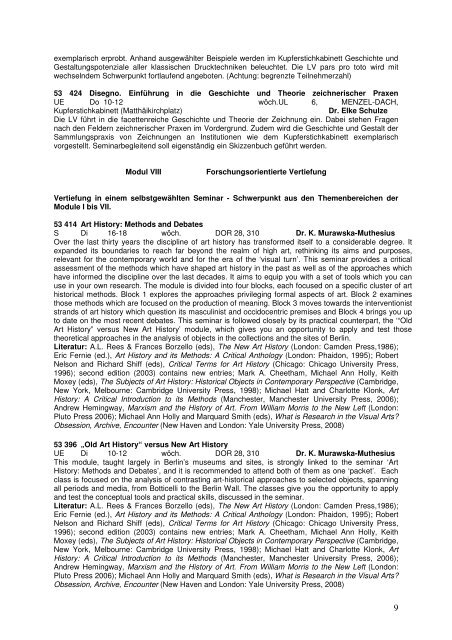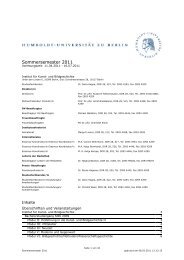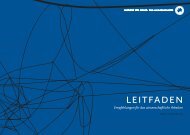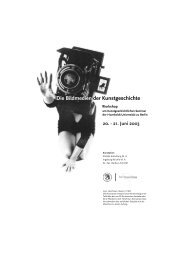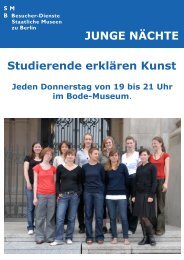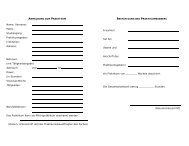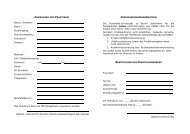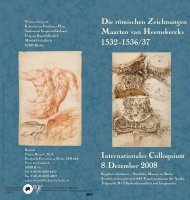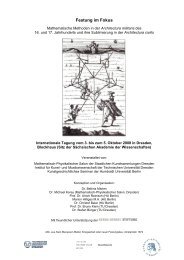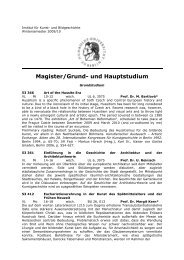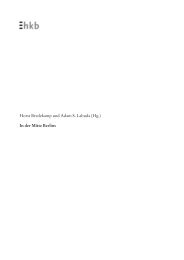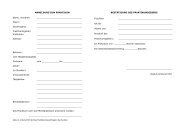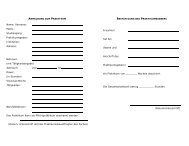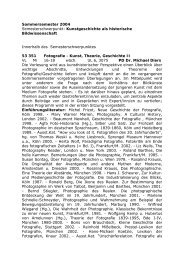Master (pdf) - Institut für Kunst- und Bildgeschichte
Master (pdf) - Institut für Kunst- und Bildgeschichte
Master (pdf) - Institut für Kunst- und Bildgeschichte
Sie wollen auch ein ePaper? Erhöhen Sie die Reichweite Ihrer Titel.
YUMPU macht aus Druck-PDFs automatisch weboptimierte ePaper, die Google liebt.
exemplarisch erprobt. Anhand ausgewählter Beispiele werden im Kupferstichkabinett Geschichte <strong>und</strong><br />
Gestaltungspotenziale aller klassischen Drucktechniken beleuchtet. Die LV pars pro toto wird mit<br />
wechselndem Schwerpunkt fortlaufend angeboten. (Achtung: begrenzte Teilnehmerzahl)<br />
53 424 Disegno. Einführung in die Geschichte <strong>und</strong> Theorie zeichnerischer Praxen<br />
UE Do 10-12 wöch.UL 6, MENZEL-DACH,<br />
Kupferstichkabinett (Matthäikirchplatz)<br />
Dr. Elke Schulze<br />
Die LV führt in die facettenreiche Geschichte <strong>und</strong> Theorie der Zeichnung ein. Dabei stehen Fragen<br />
nach den Feldern zeichnerischer Praxen im Vordergr<strong>und</strong>. Zudem wird die Geschichte <strong>und</strong> Gestalt der<br />
Sammlungspraxis von Zeichnungen an <strong>Institut</strong>ionen wie dem Kupferstichkabinett exemplarisch<br />
vorgestellt. Seminarbegleitend soll eigenständig ein Skizzenbuch geführt werden.<br />
Modul VIII<br />
Forschungsorientierte Vertiefung<br />
Vertiefung in einem selbstgewählten Seminar - Schwerpunkt aus den Themenbereichen der<br />
Module I bis VII.<br />
53 414 Art History: Methods and Debates<br />
S Di 16-18 wöch. DOR 28, 310 Dr. K. Murawska-Muthesius<br />
Over the last thirty years the discipline of art history has transformed itself to a considerable degree. It<br />
expanded its bo<strong>und</strong>aries to reach far beyond the realm of high art, rethinking its aims and purposes,<br />
relevant for the contemporary world and for the era of the ‘visual turn’. This seminar provides a critical<br />
assessment of the methods which have shaped art history in the past as well as of the approaches which<br />
have informed the discipline over the last decades. It aims to equip you with a set of tools which you can<br />
use in your own research. The module is divided into four blocks, each focused on a specific cluster of art<br />
historical methods. Block 1 explores the approaches privileging formal aspects of art. Block 2 examines<br />
those methods which are focused on the production of meaning. Block 3 moves towards the interventionist<br />
strands of art history which question its masculinist and occidocentric premises and Block 4 brings you up<br />
to date on the most recent debates. This seminar is followed closely by its practical counterpart, the ‘“Old<br />
Art History” versus New Art History’ module, which gives you an opportunity to apply and test those<br />
theoretical approaches in the analysis of objects in the collections and the sites of Berlin.<br />
Literatur: A.L. Rees & Frances Borzello (eds), The New Art History (London: Camden Press,1986);<br />
Eric Fernie (ed.), Art History and its Methods: A Critical Anthology (London: Phaidon, 1995); Robert<br />
Nelson and Richard Shiff (eds), Critical Terms for Art History (Chicago: Chicago University Press,<br />
1996); second edition (2003) contains new entries; Mark A. Cheetham, Michael Ann Holly, Keith<br />
Moxey (eds), The Subjects of Art History: Historical Objects in Contemporary Perspective (Cambridge,<br />
New York, Melbourne: Cambridge University Press, 1998); Michael Hatt and Charlotte Klonk, Art<br />
History: A Critical Introduction to its Methods (Manchester, Manchester University Press, 2006);<br />
Andrew Hemingway, Marxism and the History of Art. From William Morris to the New Left (London:<br />
Pluto Press 2006); Michael Ann Holly and Marquard Smith (eds), What is Research in the Visual Arts?<br />
Obsession, Archive, Encounter (New Haven and London: Yale University Press, 2008)<br />
53 396 „Old Art History“ versus New Art History<br />
UE Di 10-12 wöch. DOR 28, 310 Dr. K. Murawska-Muthesius<br />
This module, taught largely in Berlin’s museums and sites, is strongly linked to the seminar ‘Art<br />
History: Methods and Debates’, and it is recommended to attend both of them as one ‘packet’. Each<br />
class is focused on the analysis of contrasting art-historical approaches to selected objects, spanning<br />
all periods and media, from Botticelli to the Berlin Wall. The classes give you the opportunity to apply<br />
and test the conceptual tools and practical skills, discussed in the seminar.<br />
Literatur: A.L. Rees & Frances Borzello (eds), The New Art History (London: Camden Press,1986);<br />
Eric Fernie (ed.), Art History and its Methods: A Critical Anthology (London: Phaidon, 1995); Robert<br />
Nelson and Richard Shiff (eds), Critical Terms for Art History (Chicago: Chicago University Press,<br />
1996); second edition (2003) contains new entries; Mark A. Cheetham, Michael Ann Holly, Keith<br />
Moxey (eds), The Subjects of Art History: Historical Objects in Contemporary Perspective (Cambridge,<br />
New York, Melbourne: Cambridge University Press, 1998); Michael Hatt and Charlotte Klonk, Art<br />
History: A Critical Introduction to its Methods (Manchester, Manchester University Press, 2006);<br />
Andrew Hemingway, Marxism and the History of Art. From William Morris to the New Left (London:<br />
Pluto Press 2006); Michael Ann Holly and Marquard Smith (eds), What is Research in the Visual Arts?<br />
Obsession, Archive, Encounter (New Haven and London: Yale University Press, 2008)<br />
9


